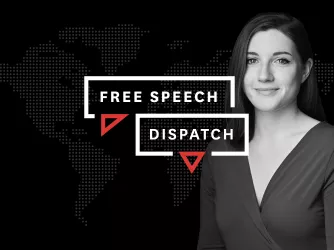Table of Contents
A Closer Look at FIRE’s ‘Susan B. Anthony List’ Brief

As announced earlier this week, FIRE filed an amicus curiae (“friend of the court”) brief (PDF) with the Supreme Court of the United States on Monday in the case of Susan B. Anthony List v. Driehaus. Because the case is an important one for FIRE’s work challenging speech codes in court, it’s worth taking a closer look at the stakes and our arguments.
So what’s Susan B. Anthony List v. Driehaus about, and what’s FIRE’s concern with it?
The case involves a First Amendment challenge to an Ohio law prohibiting “false statements” in electoral campaigns. The challenge to the law’s constitutionality was brought in October 2010 by the Susan B. Anthony List (SBA List), a pro-life nonprofit organization that had planned to purchase billboards criticizing U.S. Representative Steve Driehaus’ vote on the Affordable Care Act. The billboards never actually materialized because the billboard company refused to sell the space to SBA List after Driehaus threatened to sue. Nevertheless, Driehaus filed a complaint about SBA List with the Ohio Elections Commission under the state’s “false statements” law.
A panel of Ohio Elections Commission members found “probable cause” to refer Driehaus’ complaint to the full Commission for a hearing in two weeks’ time, per the law’s procedures. In response, SBA List filed suit in federal district court, challenging the law’s constitutionality and seeking an injunction against its enforcement. The district court declined to grant SBA List the injunctive relief it sought, but the parties agreed to delay the Ohio Elections Commission hearing until after the election, which Driehaus lost. Having failed to win reelection, Driehaus withdrew his complaint with the Ohio Elections Commission—but SBA List, understandably aggrieved by the proceedings, amended its complaint shortly thereafter, pointing out that they remained subject to a similar speech-chilling hassle as long as the “false statements” law remained on the books.
The district court dismissed SBA List’s suit (which had at this point been joined by another advocacy organization, also concerned about the law’s impact on its campaign-related speech), holding that SBA List’s complaint wasn’t “ripe” for adjudication and that SBA List didn’t have standing to bring its challenge to the law’s constitutionality.
SBA List appealed to the United States Court of Appeals for the Sixth Circuit—and this is where things get interesting for FIRE’s purposes.
On appeal, the Sixth Circuit upheld the lower court’s ruling and confirmed its rationale for dismissing the case, finding that SBA List lacked standing to sue. That’s right: Despite the fact that SBA List had been hauled before the Ohio Elections Commission because of Ohio’s law, where a panel of Commission members had found “probable cause” to proceed to a full hearing, the Sixth Circuit nevertheless held that SBA List couldn’t bring suit because, in the Sixth Circuit’s estimation, the group was unable to demonstrate “an imminent threat of future prosecution” (emphasis in original). Concluding that “[n]o sword of Damocles dangles over SBA List to justify its fears,” the Sixth Circuit labeled SBA List’s concern about being called to account for its speech again in the future to be mere “conjecture”—again, ignoring the fact that the law under which SBA List was hauled in front of a government agency was still on the books, available to anybody who might disagree with SBA List’s speech.
The Sixth Circuit’s decision is deeply worrying to FIRE because it raises the bar for plaintiffs seeking to challenge laws or regulations on First Amendment grounds. Courts have traditionally recognized a lower degree of harm sufficient for suit in First Amendment cases, relaxing standing requirements to allow plaintiffs to vindicate their expressive rights (as well as those of similarly situated citizens not before the court) without first risking punishment. So by upholding the dismissal of SBA List’s complaint on standing grounds, the Sixth Circuit broke sharply with other appellate courts with regard to the type of harm a First Amendment plaintiff challenging a law—or, say, a college speech code—needs to demonstrate. As our brief to the Supreme Court explains:
The Sixth Circuit’s approach is both an outlier and mistaken. This Court and the lower courts have made clear that plaintiffs are not required to risk punishment—whether by conceding their speech is “false,” “harassing,” “hateful,” or otherwise proscribed—in order to assert a claim. See Dombrowski v. Pfister, 380 U.S. 479, 486 (1965) (explaining that, if otherwise, “free expression—of transcendent value to all society, and not merely to those exercising their rights—might be the loser”); see also Ariz. Right to Life Political Action Comm. v. Bayless, 320 F.3d 1002, 1006 (9th Cir. 2003) (“In an effort to avoid the chilling effect of sweeping restrictions, the Supreme Court has endorsed what might be called a ‘hold your tongue and challenge now’ approach rather than requiring litigants to speak first and take their chances with the consequences.”).
If the Sixth Circuit’s high bar to standing is upheld by the Supreme Court, then college students and faculty whose speech is chilled by overly broad and vague speech codes will be denied the opportunity to seek judicial relief. In our brief, we argue:
[T]he Sixth Circuit’s rule requiring plaintiffs to allege an intention to violate the provision of law at issue not only is wrong as a doctrinal matter, it is particularly pernicious in the educational setting. At a school with an overbroad speech or harassment code, virtually no one actually intends to harass or be “hateful” in her speech, and that is not what the pre-enforcement review is about. The concern, instead, is that protected speech on important but sensitive issues will be deemed “harassing” or “hateful” under an impossibly vague harassment or speech code. See DeJohn, 537 F.3d at 317 (“Further, the policy’s use of ‘hostile,’ ‘offensive,’ and ‘gender-motivated’ is, on its face, sufficiently broad and subjective that they ‘could conceivably be applied to cover any speech’ of a ’gender-motivated’ nature ‘the content of which offends someone.’”) (quoting Saxe v. State College Area Sch. Dist., 240 F.3d 200, 217 (3d Cir. 2001) (Alito, J.)). This is to say that the student at a school with a speech code does not intend to violate the code but has no way of actually knowing whether or not she will be prosecuted; the student, understandably, will self-censor as a matter of prudence to avoid punishment.
[...]
The point of all this is that if a university scholar were required to admit to violating a speech code in order to challenge its constitutionality, then for all practical purposes that scholar would never be able to bring a facial overbreadth challenge with respect to that code—thus eradicating access to the core means by which academic freedom is protected. Indeed, without the availability of pre-enforcement facial challenges, few, if any, students or faculty would ever admit to violating a campus speech or harassment code, rendering such codes immune from challenge and perpetually chilling protected student speech. And yet this is precisely what the Sixth Circuit’s decision here will encourage—certainly in the university context. At bottom, it is hard to postulate a state of affairs more offensive to the continued vigor of First Amendment freedoms on our college campuses, and FIRE thus respectfully submits that the Court should reverse the appellate court’s decision and make clear that there is no room in our country’s classrooms for this sort of “pall of orthodoxy” to be cast down from above by university administrators. Keyishian, 385 U.S. at 603.
Check out our full brief (PDF) for our entire argument. As noted on Tuesday, FIRE is deeply grateful to Jeffrey A. Rosen of Kirkland & Ellis LLP, our counsel of record, and his team: John K. Crisham, Jennifer M. Bandy, and Michael A. Fragoso. Their generous assistance, offered pro bono, allowed FIRE to provide the Court with our unique perspective on the case and the importance of the interests at stake.
For more on the threat to free speech presented by the Sixth Circuit’s decision, check out the brief filed by our colleagues in the First Amendment Lawyers Association. And for a lighter touch, be sure to read the brief (PDF) authored by the Cato Institute’s Ilya Shapiro and preeminent satirist P.J. O’Rourke—an instant classic, dubbed the “Best Amicus Brief Ever” by Above The Law.
Of course, we’ll have more on the case when the Court issues its decision some months from now. Stay tuned.
Recent Articles
FIRE’s award-winning Newsdesk covers the free speech news you need to stay informed.

FIRE’s defense of pollster J. Ann Selzer against Donald Trump’s lawsuit is First Amendment 101

Cosmetologists can’t shoot a gun? FIRE ‘blasts’ tech college for punishing student over target practice video

China’s censorship goes global — from secret police stations to video games
